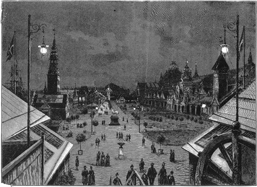
Hedebo Embroidery was shown at the World Exhibitions throughout the second half og the 19th century, as well as at the Great Nordic Industry, Agriculture and Art Exhibition in Copenhagen in 1888. The drawing shows this Nordic exhibition. The buildings are designed by the architect Martin Nyrop, who was one of those working to make Hedebo Embroidery known throughout the world.
Hedebo Embroidery became famous all over the world. In the last half of the 19th century this Danish peasant embroidery was displayed in several world exhibitions. At the beginning of the 20th century, Hedebo Embroidery could be found in foreign embroidery and pattern books. Hedebo Embroidery shares a common European cultural heritage, taking inspiration from the Byzantine Empire of mediaeval times.
World Exhibitions
The 19th century is famous for being the century of World Exhibitions: the national and market economy window on to the world of that time. Hedebo Embroidery was shown at the London World Exhibition in 1862, in Vienna in 1873, in Paris in 1877, in Chicago in 1892, and Paris again in 1900. In 1862 Hedebo Embroidery was shown together with a doll dressed in a Hedebo dress. In 1873 and 1877, Julie Augusta Valentiner, the wife of the owner of a great estate, Gjeddesdal Manor, on the Heath, exhibited Hedebo Embroidery which one of the local farm girls had stitched. In 1873 Mrs. Valentiner received an “employee’s medal”, and in 1877 a bronze medal for the embroideries. In Chicago, the popular Hedebo Embroidery of the “artistically revived” version represented Danish embroidery and received the American Press’s praises. In 1900 Hedebo Embroidery was shown in the Paris exhibition, but other forms of embroidery dominated it.
Foreign Embroidery Books
The Danish Hedebo Embroidery at the World Exhibition in 1877 is presumably the reason for a French embroidery encyclopaedia from 1884 speaking highly of Hedebo Embroidery under both white embroidery and needle lace. At the beginning of the 20th century, English books on Hedebo Embroidery, especially ”Udklipshedebo”, were published. At that time “Udklipshedebo” was deprecated in Denmark, whereas “Hvidsøm” and “Baldyring” were considered to be the original Hedebo Embroidery.
Cultural Heritage
Hedebo Embroidery is famous among the world’s embroidery experts. Together with other white stitching on white linen, these embroideries are both unique and at the same time represent a common cultural heritage, dating back to the influence of the Byzantine Empire on southern Europe in mediaeval times. The sources of inspiration are not linear. The Vikings may have brought home embroideries which inspired the Hardanger embroideries, and the drawn thread work and counted thread work of Hedebo Embroidery. The ’reticella’ of Renaissance Italy has presumably been the source of inspiration for the “Baldyring” variation of Hedebo Embroidery in the 19th century. Later both French and English embroideries were integrated into Danish needle lace.
